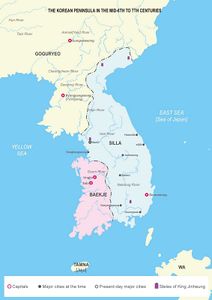Balhae: Shared History of Korea and China
In 676 the Korean Peninsula was unified by the Silla kingdom; however, it was unable to take over the whole peninsula and Manchuria, which had been the territory of the Three Kingdoms. It occupied and governed the southern two thirds of the peninsula, with the area above today's Pyeongyang as the northern border for more than two centuries.
China’s Tang dynasty, which had allied with Silla to defeat the Goguryeo kingdom, tried to bring the northern part under its rule but failed due to the resistance of Goguryeo refugees.
At the center of resistance was Dae Jo-yeong, who founded a new state in 698 named Balhae; its royal family hailed from the aristocracy of Goguryeo, and hence Balhae professed to be Goguryeo's successor.
Tang and Silla joined forces to repeatedly attack Balhae and stop it from expanding. Balhae strongly resisted, seeking to recover Goguryeo territory, and through these battles expanded its territory to cover the top part of today’s North Korea, the northeastern part of China and the Maritime Province of Siberia in Russia. With Balhae territory straddling three countries in this way, each country lays claim to Balhae's history.
China sees Balhae as a province of the Tang dynasty because part of Balhae territory now lies within China, and because Tang invested some of Balhae's kings. But if Balhae was indeed a part of Tang, there would have been no need for territorial battles.
Russia is also trying to claim Balhae's history. Korea, of course, considers Balhae to be part of Korean history along with Silla. When Balhae and Silla fell, giving way to the new state of Goryeo, Goryeo's founding monarch, Wang Geon, accepted some Balhae refugees as the descendants of Goguryeo.
Balhae was composed of various peoples, including Goguryeo people and Mohe people. Its culture was based on that of Goguryeo, as evidenced by the tombs of princesses Jeonghyo and Jeonghye which are Goguryeo style, for example, but also assimilated influences from Tang and various other cultures.
It is clear that Balhae’s ruling class came from Goguryeo lineage. However, as Balhae was comprised of many cultures and peoples, it is important to properly understand its unique, multicultural nature.


